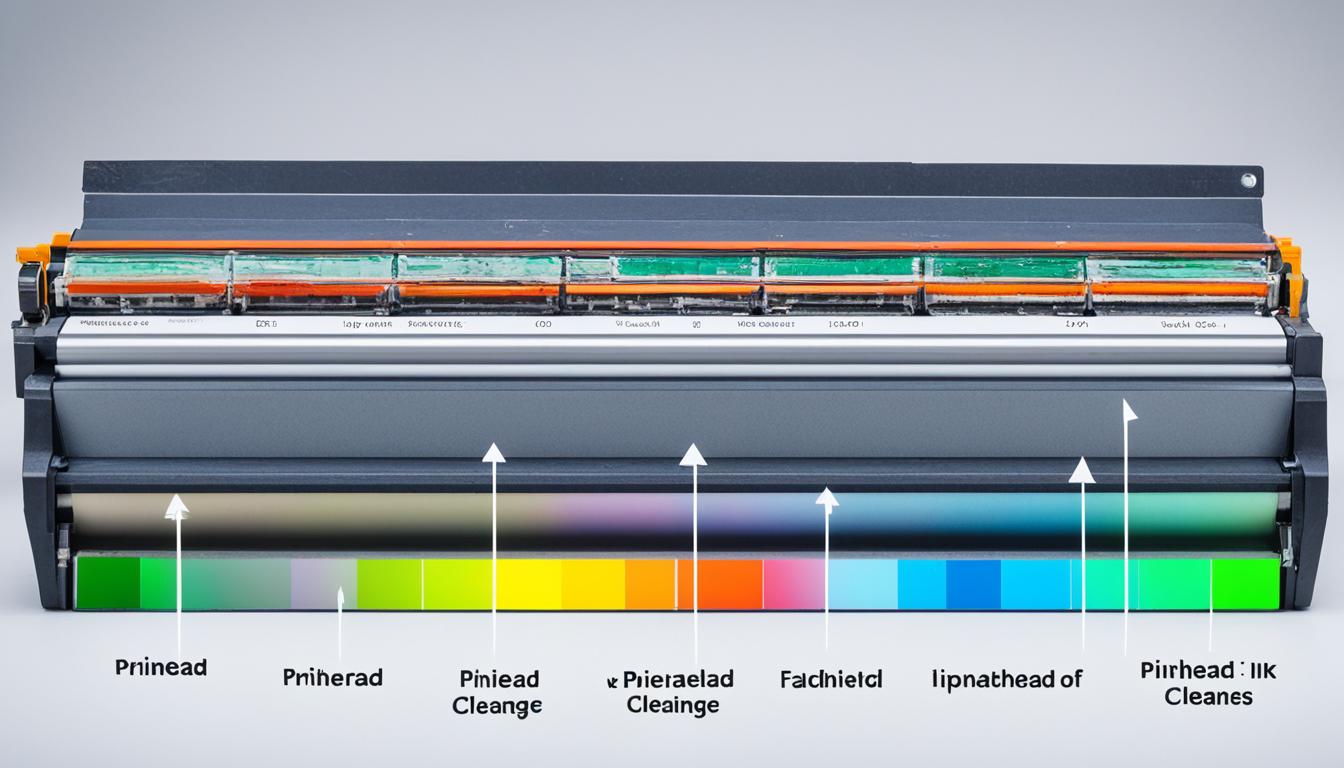When it comes to the lifespan of a printhead, several factors come into play. From the brand of the printer to proper installation and maintenance, these elements can significantly impact the durability of your printhead. As a delicate and expensive consumable, it’s essential to understand the factors that can affect its lifespan and how to maximize its longevity.
Printheads are exposed to various risks that can lead to premature failure. Factors such as abrasion, contamination, corrosion, electrostatic discharge (ESD), and residue buildup can all take a toll on your printhead. However, by incorporating routine preventive maintenance, using high-quality media, and avoiding physical contact, you can help extend the lifespan of your printhead.
Key Takeaways:
- The lifespan of a printhead can vary depending on the brand of the printer.
- Abrasion, contamination, corrosion, ESD, and residue buildup can lead to premature printhead failure.
- Perform routine preventive maintenance to maximize the lifespan of your printhead.
- Using high-quality media and avoiding physical contact with the printhead can help prolong its longevity.
- Proper installation and maintenance are crucial for extending the lifespan of your printhead.
Printhead Lifespan in Thermal Printers
Thermal printheads play a crucial role in the performance and durability of printers like Zebra, Datamax, SATO, and Printronix. These printheads have a measured lifespan in millions of linear inches printed, making them a long-lasting solution for thermal label printing. However, it is important to note that the actual lifespan can vary depending on several factors.
One of the key factors influencing thermal printhead lifespan is print volume. Higher print volumes tend to result in more wear and tear on the printhead, potentially reducing its overall lifespan. Therefore, it is important to consider the intended usage and select a thermal label printer with a printhead designed to withstand the desired print volume.
Installation and long-term maintenance also significantly impact the lifespan of thermal printheads. Proper installation and ensuring correct printhead pressure and alignment are crucial for optimal performance and longevity. Additionally, regular cleaning of the platen and printhead is essential to prevent residue buildup and maintain print quality.
“To extend the lifespan of thermal printheads, it is important to use proper media, clean the platen and printhead regularly, balance printhead pressure, adjust print speed, monitor room temperature, use protective enclosures, and follow a regular cleaning and maintenance schedule.”
Another important aspect to consider is the selection of media. Using high-quality media that is compatible with thermal printers can help minimize printhead abrasion and reduce potential damage or contamination.
Monitoring room temperature is also crucial, as excessively high or low temperatures can negatively impact the performance and lifespan of the thermal printhead. Using protective enclosures can help maintain a stable and controlled environment for optimal print quality and printhead longevity.
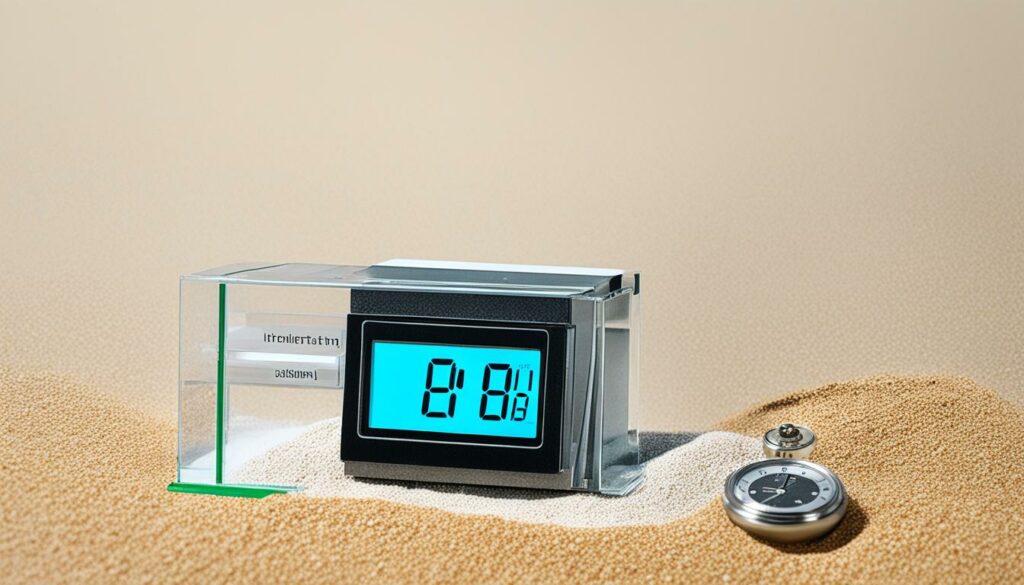
By following a regular cleaning and maintenance schedule, adjusting print speed, and implementing these best practices, users can maximize the lifespan of thermal printheads, reducing the need for frequent replacements and overall maintenance costs. Moreover, ensuring proper maintenance of thermal printheads contributes to consistent print quality and reliable label printing operations.
Lifespan of Print Heads in Wide Format Printers
The advancement of technology has significantly improved the lifespan of print heads in wide format printers. Unlike older models that lasted for only a few thousand prints, modern print heads can now endure tens of thousands of prints. Various factors contribute to the longevity of a print head, including the type of ink used, the media printed on, and the environmental conditions it operates in.
Eco-solvent and UV-curable inks, known for their durability, can extend the lifespan of print heads in wide format printers. These inks provide better resistance to wear and tear, resulting in a longer-lasting print head. Additionally, the type of media printed on can affect durability. Coated media, for example, causes less abrasion and reduces stress on the print head, helping to prolong its lifespan.
Environmental conditions also play a crucial role in print head longevity. Factors such as temperature, humidity, and dust levels can affect the performance and lifespan of the print head. Maintaining optimal conditions, such as a dust-free and properly ventilated environment, can help ensure the print head remains in good working condition for an extended period.
On average, the lifespan of a print head in a wide format printer can range from several hundred to several thousand hours of usage. However, it is important to note that individual usage patterns and maintenance practices can influence the actual lifespan of the print head. Proper care, routine cleaning, and adherence to manufacturer maintenance guidelines are essential for maximizing the lifespan and performance of print heads in wide format printers.
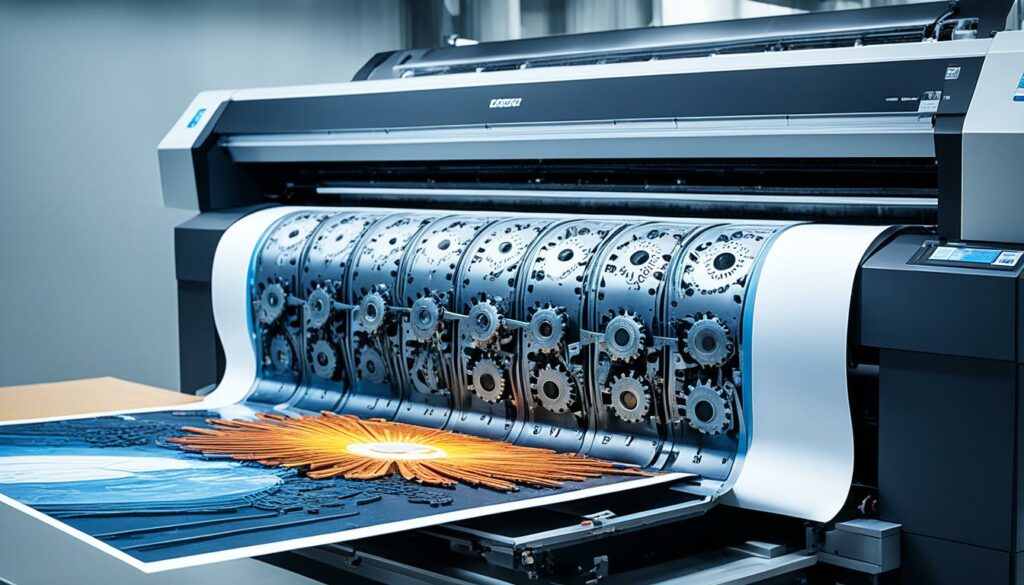
Factors Affecting Print Head Lifespan
The lifespan of print heads in wide format printers can be impacted by several factors:
- Type of ink used: Eco-solvent and UV-curable inks offer better durability, leading to an extended print head lifespan.
- Type of media printed on: Coated media reduces wear and tear on print heads, increasing their longevity.
- Environmental conditions: Optimal temperature, humidity, and dust levels contribute to a longer-lasting print head.
Comparing Print Head Lifespans in Different Wide Format Printer Brands
| Brand | Average Print Head Lifespan |
|---|---|
| Epson | 2-4 years |
| Canon | 1-3 years |
| HP | 1-2 years |
Proper installation, regular maintenance, and adherence to manufacturer guidelines are essential for extending the lifespan of print heads in wide format printers.
Factors Influencing Print Head Lifespan in Wide Format Printers
The lifespan of a print head in a wide format printer is influenced by several factors. It is essential to understand and address these factors to maximize the print head’s longevity and ensure optimal performance.
Environmental Conditions
The environment in which a wide format printer operates can significantly impact the print head’s lifespan. Factors such as temperature, humidity, and dust levels can affect the print head’s performance and longevity. Extreme temperatures and high humidity can cause thermal stress and lead to premature wear and tear. Dust particles can accumulate on the print head and obstruct ink flow, resulting in diminished print quality and potential damage.
Type of Print Head
The type of print head used in a wide format printer also plays a role in its lifespan. There are two primary types of print heads: thermal and piezoelectric. Thermal print heads, commonly found in inkjet printers, use heat to propel tiny droplets of ink onto the media. Piezoelectric print heads, on the other hand, use electrical charges to create pressure and eject ink droplets. While both types can deliver excellent print quality, the durability and lifespan may differ. It is crucial to choose a printer with a print head technology that aligns with your specific needs and requirements.
Ink and Media Type
The quality of ink and type of media used in a wide format printer can impact the print head’s lifespan. Using compatible, high-quality ink formulated for the specific printer model can minimize the risk of clogs and residue buildup, which can lead to print head failure. Likewise, using media that is compatible with the printer and properly coated can reduce friction and wear on the print head, extending its lifespan.
Frequency and Type of Usage
Another factor that can influence the print head’s lifespan is the frequency and type of usage. Print heads used excessively or for prolonged periods without breaks may experience increased wear and tear. Moreover, print heads used in dusty or humid environments may be more prone to clogging and damage. Regular maintenance, including cleaning and proper servicing, can mitigate these risks and extend the print head’s lifespan.
By considering these factors and implementing proper maintenance practices, users of wide format printers can maximize the lifespan of their print heads, resulting in consistent print quality and cost-effective operations.
Average Lifespan of Print Heads in Different Brands of Wide Format Printers
The lifespan of a print head in a wide format printer can vary depending on the brand. Different wide format printer brands have their own unique design and manufacturing processes that can impact the longevity of their print heads.
Among the various brands available in the market, Epson wide format printers are known for their exceptional print head lifespan compared to other brands. Epson’s print heads are built with high-quality materials and advanced technology, ensuring durability and reliability.
On average, a print head in a wide format printer can last between 2-4 years. However, it’s important to note that this lifespan is an estimate and can vary depending on several factors, including usage patterns, maintenance practices, and environmental conditions.
To maximize the lifespan of a print head in a wide format printer, proper maintenance is crucial. Regular cleaning of the print head and its surrounding components helps prevent clogs and ensures optimal performance. Creating a dust-free environment and implementing a scheduled maintenance routine can further enhance the print head’s lifespan.
Additionally, using genuine and compatible ink cartridges designed for the specific printer model is essential. Poor-quality ink can lead to clogs and premature wear of the print head, negatively impacting its lifespan.
Awareness of brand-specific maintenance recommendations and following them diligently can significantly extend the lifespan of a print head, ultimately reducing operating costs and improving print quality.
Comparison of Print Head Lifespan by Brand
| Brand | Average Lifespan |
|---|---|
| Epson | 2-4 years |
| Canon | 1-3 years |
| HP | 1-2 years |
| Roland | 1-3 years |
Note: The data provided in the table is an average estimate based on industry knowledge and feedback from users. Actual print head lifespan may vary.
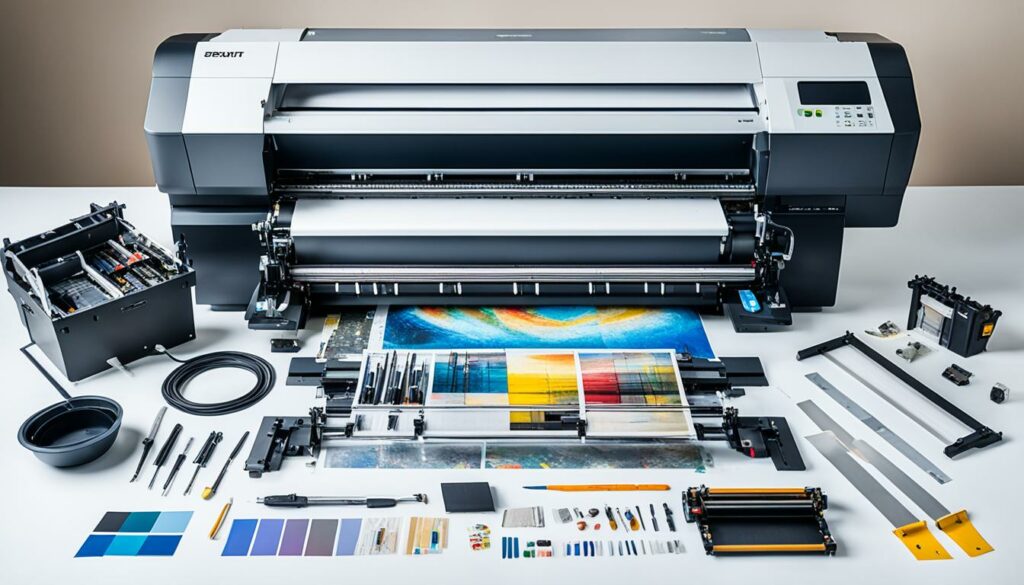
Maintenance Practices to Prolong Print Head Lifespan in Wide Format Printers
Regular maintenance practices are crucial for prolonging the lifespan of a print head in a wide format printer. By implementing proper maintenance techniques, you can keep your print head functioning optimally and extend its longevity.
1. Cleaning the Print Head, Nozzle Plate, and Printer Head Carriage
Regularly cleaning the print head, nozzle plate, and printer head carriage is essential for maintaining the print head’s longevity. These components can accumulate ink residue, dust particles, and other contaminants over time, which can impede print quality and potentially damage the print head. Use a cleaning solution specifically designed for wide format printers and follow the manufacturer’s instructions for safe and effective cleaning.
2. Ensuring a Dust-Free Environment
Avoiding dust and debris is crucial for preventing damage to the print head. Dust particles can adhere to the print head or clog the nozzle, resulting in poor print quality and potential malfunction. Keep your printer in a clean and dust-free environment, preferably in an enclosure or dedicated room with proper air filtration systems. This will help minimize the risk of dust-related issues and prolong the life of your print head.
3. Proper Ventilation to Prevent Overheating
Proper ventilation is essential to prevent overheating of the print head. High temperatures can cause the print head to malfunction or degrade faster. Ensure that your printer is placed in an area with adequate air circulation and avoid exposing it to direct sunlight or sources of heat. Additionally, regularly check the printer’s ventilation system, such as fans and vents, to ensure they are clean and functioning properly.
4. Regular Servicing and Timely Problem Addressing
Regular servicing by a qualified technician is important for identifying and addressing any potential problems with the print head. Timely detection and resolution of issues can prevent further damage and extend the print head’s lifespan. Implement a schedule for routine servicing and follow the manufacturer’s recommended maintenance guidelines.
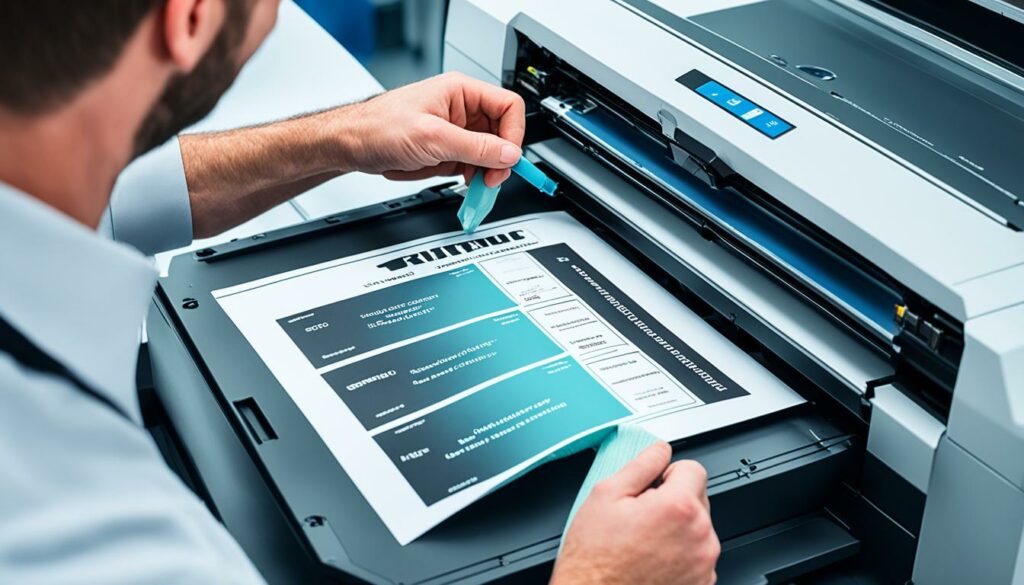
Common Signs of a Failing Print Head in a Wide Format Printer
When it comes to wide format printers, it’s important to be aware of the common signs that indicate a failing print head. By recognizing these signs early on, you can take appropriate action to address the issue and prevent further complications.
One of the first indicators of a failing print head is a decrease in print quality. You may notice missing lines, faded colors, or streaking in your prints. These issues can significantly impact the overall appearance and professional quality of your prints.
Another sign to watch out for is a decrease in print speed. If you notice that your printer is taking longer than usual to complete a print job, it could be a sign that the print head is not functioning optimally. This can result in productivity bottlenecks and potential delays in meeting deadlines.
Furthermore, a failing print head can lead to an increase in production costs. Excessive ink consumption is a common issue caused by a malfunctioning print head. This can result in wasted ink and additional expenses in replenishing supplies more frequently than necessary.
To address these issues and maintain optimal print head performance, proper maintenance and regular cleaning are crucial. By implementing a routine maintenance schedule and ensuring that your print head is free from dirt, debris, and residue buildup, you can prevent these common problems from occurring.
Keep in mind that the lifespan of a print head in a wide format printer can vary depending on various factors, but typically ranges from one to three years. Being proactive in identifying signs of print head failure and taking appropriate measures can help extend its lifespan and avoid unnecessary costs.
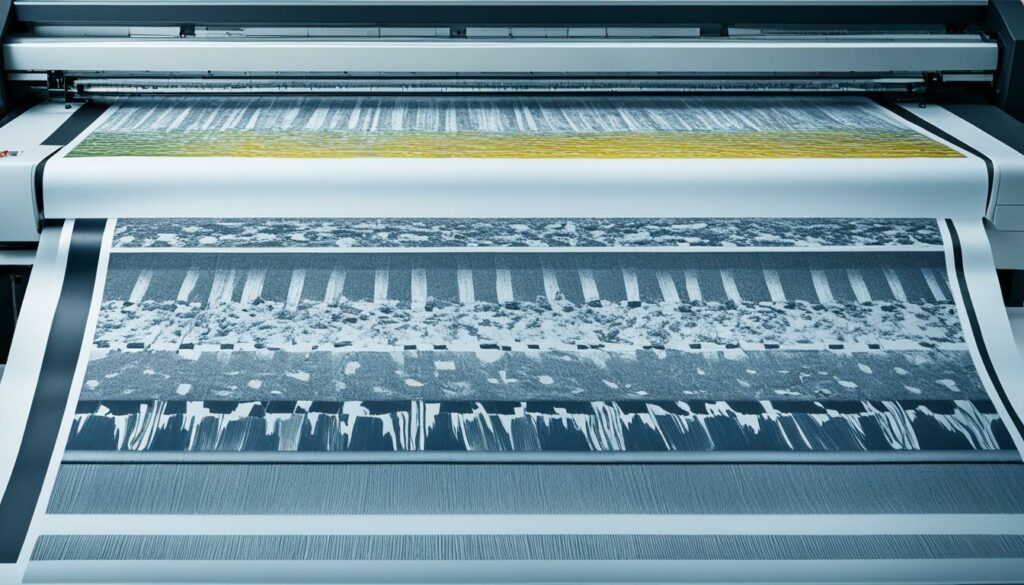
Signs of a Failing Print Head in a Wide Format Printer
| Signs of Failing Print Head |
|---|
| Decrease in print quality (missing lines, faded colors, streaking) |
| Decrease in print speed |
| Increase in production costs (excessive ink consumption) |
Cost and Process of Replacing a Print Head in a Wide Format Printer
When it comes to replacing a print head in a wide format printer, the cost can vary based on several factors. These include the make and model of the printer and the specific type of print head being replaced. The process itself involves removing the old print head and installing a new one. Depending on the printer, this may require disassembling certain parts or simply pressing a button to release the old print head.
It is crucial to consult the printer’s manual and follow the specific instructions provided when replacing the print head. This ensures a smooth and successful replacement process, minimizing the risk of any damage or errors that could arise.
The cost of replacing a print head in a wide format printer can range from a few hundred to thousands of dollars. This cost typically includes the price of the new print head itself as well as any labor costs involved in the replacement process.
Considering the potential expense and complexity involved in print head replacement, it highlights the importance of proper maintenance practices for prolonged print head longevity. By implementing regular cleaning, adhering to a dust-free environment, and following recommended maintenance routines, the need for frequent print head replacement can be minimized, saving both time and money.
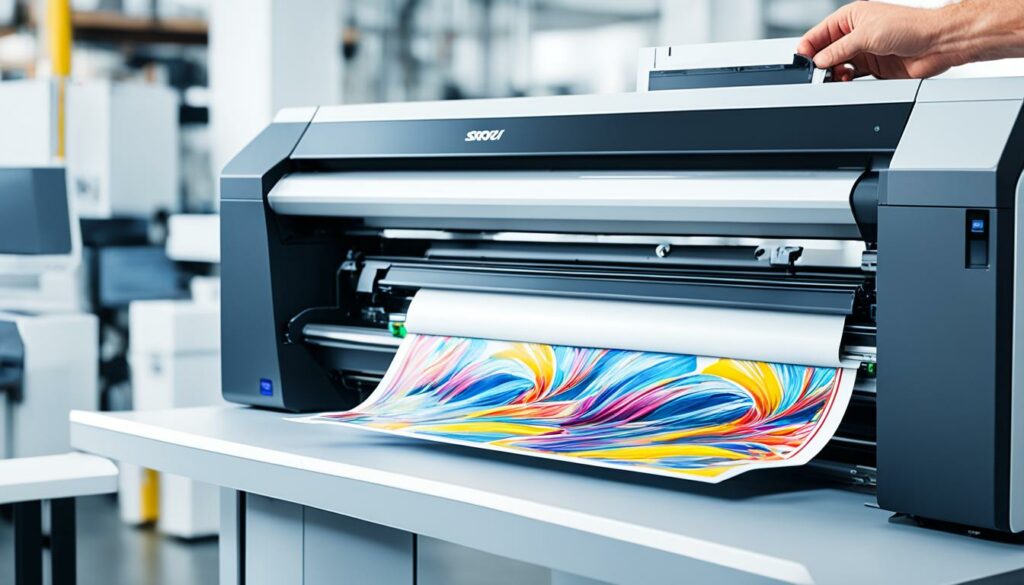
| Wide Format Printer Brand | Average Cost of Print Head Replacement |
|---|---|
| Epson | $500 – $1,500 |
| Canon | $800 – $2,000 |
| HP | $700 – $1,800 |
| Roland | $600 – $1,500 |
Helpful Tips for Print Head Replacement:
- Consult the printer’s manual for specific instructions
- Ensure a clean and dust-free environment during the replacement process
- Use caution when handling the print head to avoid any physical damage
- Follow proper installation procedures to ensure a secure fit
- Perform a test print to verify proper functioning after replacement
Importance of Maintenance Practices for Print Head Longevity
The maintenance practices implemented for a print head in a wide format printer significantly affect its longevity. To ensure optimal performance and maximize the lifespan of the print head, it is essential to prioritize regular cleaning, maintaining a dust-free environment, and following proper maintenance procedures.
Regularly cleaning the print head is crucial in preventing clogs and buildup that can negatively impact print quality. Unwanted particles such as dirt, dust, and debris can accumulate on the print head over time, causing blockages and affecting the accuracy of ink deposition. By regularly cleaning the print head, you can keep it free from contaminants and ensure optimal printing results.
Creating a dust-free environment is equally important in maintaining print head longevity. Dust particles can infiltrate the printer and settle on the print head, leading to clogs, uneven ink distribution, and decreased print quality. By implementing strategies to minimize dust exposure, such as using protective enclosures or positioning the printer in a clean area, you can mitigate the risk of print head damage and prolong its lifespan.
In addition to cleaning and dust control, proper ink cartridge replacement and ventilation play crucial roles in maintaining print head longevity. Using genuine, high-quality ink cartridges and replacing them when necessary helps ensure consistent ink flow and prevents potential ink-related issues that can jeopardize the print head’s lifespan. Adequate ventilation helps prevent overheating, which can impact the performance and reliability of the print head.
Regular servicing by qualified technicians is also an essential aspect of print head maintenance. Periodic maintenance and inspections can help identify any potential issues before they escalate, allowing for timely repairs or replacements. By addressing any problems promptly, you can prevent further damage and extend the print head’s lifespan.
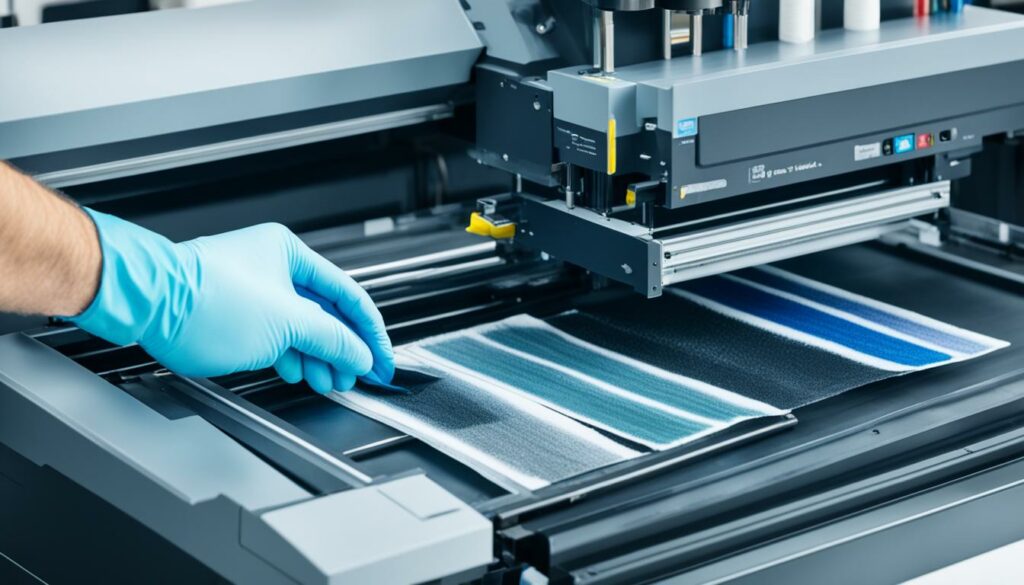
Implementing these maintenance practices for your wide format printer’s print head will not only extend its lifespan but also ensure high-quality prints for a longer period of time. By dedicating time and effort to regular cleaning, maintaining a dust-free environment, and following proper maintenance procedures, you can maximize the value of your print head investment and optimize the overall performance of your wide format printer.
Conclusion
After analyzing the various factors influencing the lifespan of a printhead, it is clear that proper installation, long-term maintenance, and regular cleaning are crucial for maximizing its durability. The type of printer, brand, ink, and media used also play a significant role in determining the printhead’s lifespan. While the average lifespan can vary, implementing cost-effective maintenance practices can significantly extend its longevity and enhance print quality.
By considering the unique factors of each printer and implementing appropriate maintenance practices, businesses can ensure optimal printhead durability and cost-effective operations. Regular cleaning, maintaining a dust-free environment, proper ink cartridge replacement, and regular servicing are key factors in prolonging the printhead’s lifespan. These practices not only extend the lifespan but also result in high-quality prints for a longer period, reducing the need for frequent printhead replacements.
Investing in the maintenance and care of printheads not only improves their lifespan but also reduces production costs in the long run. By implementing cost-effective practices, businesses can minimize downtime, decrease the frequency of printhead replacements, and ensure consistent print quality. Effective maintenance practices, coupled with proper installation and the use of high-quality media, contribute to cost savings and overall efficiency.
In conclusion, understanding the importance of maintenance practices and implementing cost-effective strategies are key to maximizing the lifespan of printheads. By prioritizing proper installation, regular cleaning, and routine maintenance, businesses can optimize printhead longevity, reduce costs, and achieve high-quality prints throughout their lifespan.

Morgan Azhari, the owner of PrinterUpdate.net, is a dedicated expert in the field of printers, leveraging a wealth of experience and education to create a platform that passionately shares insights and solutions.
With a goal to enhance the printer user experience, my vision for the website is to provide valuable content, making a positive impact on individuals navigating the complexities of printers.
